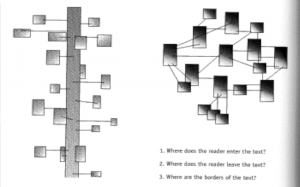George P Landow’s text really stole my attention this week. Coming from a history of limited knowledge in the subject of hypertexts, I found this article provoked my eagerness to go out and find out more, chat to my peers and suss out what hypertexts are and why they can be so helpful in making links in both communicative and educational platforms.
Essentially Landow explores the e-book system and the hypertext system.
They look something like this… (Note I’ve taken these from Landow’s text ‘Hypertext 3.0).
The first image represents the linear pathway found in e-books. E-books, as the name suggests continue to follow the linear progression, in a similar way that books do, but simply on a more interactive way. The second image demonstrates the pathways taken (or not taken) in a hypertext. Essentially, it is non-linear, and the reader may choose whichever pathway they wish. It is important to note here the traditional linear progression which is embedded in our society when it comes to books (i.e. As I have covered in earlier blogs, books take a beginning, middle and end approach in the way they reveal information and steer the reader). Whereas, the hypertext is very much in line with Ted Nelson’s idea of how information should follow links in many directions, with on link which can go many ways, so that the reader may make their own path on the network. The hypertext positions primary text in a network of links. In this sense, it is “borderless” (Landow, page 115).
Landow explains that “hypertext enables new forms of the academic essay, book review, and thesis”. It can be said that in providing all the research available on a subject but with multiple pathways can assist the research in honing in on their specified pathway.
There are 3 basic forms of academic genres:
– Author places a text without links into an HTML template that includes navigation links (simple)
– Author creates a document with links to documents on the same website and on other websites
– The author gives their research document to be made part of a network of documents or collates and produces this network. They either allow the document to stand alone or to take part in a larger web (page 3, 4)
Blogs can be explained as “a new kind of discursive prose in digital form” which challenge the genre that originally came about when writing first took physical form through “physical marks on physical surfaces”. (page 78)
Unlike diaries or books, blogs have the ability to present their content in reverse chronological order, therefore showing the reader the most up to date content and communication, while some allow readers to also leave their comment on a blog post. This never happened before with books or physical diaries. People couldn’t read Anne Frank or Summer Land (fantastic and HILARIOUS new book out!! And, she’s only 24! Good read) and ask them what they meant by a phrase or how they felt, or their opinion on an event listed in that book. Whereas now, with comments available on blogs, the reader can communicate with the author at the touch of a button.
Never before hypertexts could you link different diaries, stories or content from books together (well, at least without going through a highly tedious process or republication)…
Whereas, now, anybody can link one webpage with another, or their blog with another’s or their blog with maps, pictures, short videos to complement their entry.
While we’re at it, never before in print media such as books, magazines and academic journals could you cross reference in a click (you would have to turn the page or find the other book to which was being referred… this could entail having to drive to another library…)
This also begs the question (thanks Adrian Miles), are new media forms such as blogs becoming “an explosion of public life writing by private citizens”? As, before blogs, not everybody was writer, and certainly most people could not say that they had published anything. Whereas now, we can see that everybody now has the ability to distribute their writing publicly, publish their work and their art (photographs etc) and even report (a.k.a. Churn-alism, a term coined by BBC journalist Waseem Zakir in 2008). In fact, by May 2002, over 800, 000 blogs were recorded on the Net!
I think we can all agree that blogs can make it difficult to keep one’s privacy and personal life private from anyone (employers, employees, old friends, random people, teachers and lecturers… obviously, although this is the point to write blogs as it’s a network media subject). Because, “once a blog goes online, internet tools can bring it to the attention of [all] web surfers”.
This is why hypertexts can run into problems associated with more active readers to challenge concepts, content and validity.

